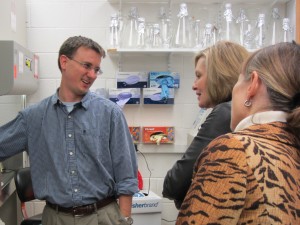The tireless team at CureBatten is in the national news again, this time for funding the launch of a clinical trial at Nationwide Children’s Hospital in Columbus, Ohio.
My heart is full of hope for Charlotte and Gwenyth Gray, daughters of Hollywood film producer Gordon Gray and his wife, Kristen. I wish I could put into words how much I want this treatment to save their beautiful little girls, Charlotte and Gwenyth. I wish I could explain how much I want the work made possible by CureBatten to spark progress for other devastating neurological diseases, including the many forms of Batten disease that still do not have a treatment.
In the hours and days after the story about the trial broke, numerous friends reached out to me congratulating me on the news.
“You must be so excited,” they said.
“Aren’t you relieved your work funding research is done, now that we have a cure?” another asked.
You see, the problem with even a well-reported story is that a lot of people only focus on the headline and the lede. They skim the rest of the article, or they’re so encouraged by the beginning, they gloss right over the part that says this fight isn’t over yet. They only register that we have a fix.
And as much as I want a miracle for the daughters of the man who produced Disney’s “Miracle,” our work is far from done.
In fact, while Charlotte and Gwenyth recover, Taylor’s Tale keeps working around the clock to bring gene therapy to light for children with infantile Batten disease. We’ve believed in our lead investigator, the University of North Carolina’s Dr. Steven Gray, for a long time. We still do.
But to get to the finish line and help children like Taylor, we still need your help.
Batten disease is a twisted, complicated monster, and I don’t expect most people to understand it. So the simplest way I can say it is this:
- There are multiple forms of Batten disease.
- Charlotte and Gwenyth have CLN6, or variant late infantile Batten disease. There are only a handful of children in the world who suffer from this form.
- There are likely thousands of children suffering from other forms of Batten disease, none of which can be directly helped by the treatment the Gray sisters received.
I also know what it’s like to believe. And even though the monster that is Batten disease is killing my little sister right in front of me, I’ve never stopped believing.
I know that someday soon, we’ll have approved treatments for children like Taylor and Charlotte and Gwenyth. Gordon Gray told People Magazine doctors advised his family to take the girls home and watch them die. My family heard that, too.
It wasn’t good enough for the Grays, and it wasn’t good enough for us.
My heart will be in my throat as the world waits for more news on Charlotte and Gwenyth. They, along with every last child fighting Batten disease, are in my prayers every night.
I just don’t want the media frenzy around a well-connected couple and their beautiful girls to paint a false picture that they – or we – are done needing your help.




4 Comments On “Why a “Miracle” in Ohio isn’t the End of this Story”